
Sacred Texts Buddhism Index Previous Next
Buy this Book at Amazon.com


India in Primitive Christianity, by Arthur Lille, [1909], at sacred-texts.com
New evidence—Five bas reliefs of the Amarâvatî Tope—They illustrate Buddha's Descent into Hell—Details of Amarâvatî Tope imitate details of an early tope—Tree Worship—Tree stem a lingam—Cairn Worship—Cairn a lingam—Roman Catholics maintain that their rites give the life of Jesus in epitome—Question examined—Not the life of the Jesus of the first three gospels—A "willing victim"—Suffers at night—Herod Antipas, the "King of the Jews"—An originality of Luke—Why brought in—His dress the same as that of a Catholic Bishop—The "Amice" the Hood-winking rag of the Freemasons—The spear thrust—Blood and water—Baby New Year in Alexandria and Tibet—Covered with flour—Tertullian on "Eleusinian dissipations."
FROM Tibet and from Ceylon we have obtained evidence that there was in S’iva Buddhism a sacrifice of the year-god of a S’ivan type. Is it corroborated? On this point I have accidentally come across some very startling matter and evidence, given by the sculptures of the Amarâvatî Tope in the British Museum. I came upon this evidence only very recently, but I do not regret the position it occupies in my little work, as without these last three chapters its full importance would not be made evident. It completely confirms all I have said about the Tibetan Mystery of the "Sacrificial Body of the Dead Year," and also the "Inebriating Festival of the Buddha"; for five bas-reliefs, which I shall reproduce, represent that festival seriatim.
The large topes were developed from the sepulchral cairn; and have for ornament a handsome railing
and four gateways all covered with bas-reliefs and stone emblems. The Amarâvatî Tope stood on the banks of the Kistna in Guntoor. It is believed to be the Dhanakacheka visited by the Chinese traveller, Hiouen Thsiang. It is believed also to be the Temple erected on the "Golden Sands" when the tooth of Buddha was brought back to India from Ceylon, after many romantic adventures in which the Princess Hemachala figured as a heroine. The celebrated Sanchi Tope and the Amarâvatî Tope, before it was broken up, must have presented at a distance a similar appearance. The dates of these Topes are very uncertain. Mr. Fergusson fixes the four gateways of the great Tope at Sanchi "within the limits of the first century A.D."; and Sir Alexander Cunningham—from 19 to 37 A.D.; but the last authority holds that the mound was set up as early as 500 B.C. The Amarâvatî Tope, in the view of Mr. Fergusson, might have been erected any time between 200 and 300 A.D. One fact in my mind throws it further back in the past than some folks suppose. Comparing this tope with the Sanchi Tope, a monument of early Buddhism, I was startled to find that the Amarâvatî Tope was of fell purpose constructed to exhibit the rites and legends of a Second Buddhism that proposed to supersede the first. It wore a masquerade dress borrowed from early Buddhism, which points to an epoch when such disguise was necessary.
That Buddhism was Saint Worship. There were seven great Saints or Buddhas. Each had his Saint's day like the Saints of the Roman Catholic Church. The rites were simple as we have shown, and centred round the Cairn where the relics of the Saint were deposited. Each had for symbol a tree in the forest; and received his flowers, food offerings, and adoration. This was the blameless Buddhist substitute for cannibalism and bloody sacrifices. With these simple
rites the sculptors of both the Sanchi and the Amarâvatî Topes covered slab after slab, holy men adoring trees and holy men adoring relic cairns.
Now S’iva Buddhism sought to wreck this reform, and re-introduce cannibalism and the bloody altar. And if you narrowly scrutinise the Tree Worship of Amarâvatî (), you see that it is not real tree worship. The tree is the Tavateinza Tree, already described, that has a stem of silver. In other words, it is the worship of the Columnar Lingam of S’iva.
A second plate () shows this very plainly. Here we get the worship of this Columnar Lingam, and a few branches are put at the top to suggest the Tavateinza Tree, the Tree of S’iva and his intoxication, the Soma Tree (Æsclapius acida). There are five or six large slabs at Amarâvatî exhibiting this worship of the Columnar Lingam. Mark, too, at the base of the smaller Lingam in this plate, the Charan or impress of Buddha's feet. Plainly, it has been cleverly converted into a grinning head of Avalokitishvara, the balls of the feet are his everlasting eyes, and the toes his terrible teeth.
In Chapter five I have already dealt with the dome-shaped lingam. Ornamental models of it are everywhere at Amarâvatî. On them is usually the five-headed Serpent; and often five Columnar Lingams, the five Dhyâni Buddhas, are sculptured on the little dome and present the appearance of the barrels of a cathedral organ. Why they are always five is a puzzle. The five Indrayas (five senses), the five Bhûtas (five material elements) have been suggested. Hodgson tells us that they are at the base of every Mahâ Chaitya (Lingam Temple) in Nepal.
It is a very important gain if we can show that at the date of the Amarâvatî Tope the story of the "Inebriating Festival of the Buddha "was in the
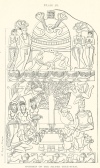
Click to enlarge
PLATE 26.
WORSHIP OF THE SILVER TREE-STEM.
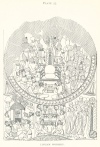
Click to enlarge
PLATE 27.
LINGAM WORSHIP.
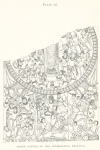
Click to enlarge
PLATE 28.
THREE SCENES IN THE INEBRIATING FESTIVAL.
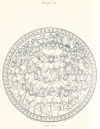
Click to enlarge
PLATE 29.
THE CUP.
ritual of the Buddhism on the mainland of Hindustan,—somewhere about 150 A.D.; and that it is depicted in ineffaceable characters on five slabs of one of its temples. I commence with slab One (See bottom of Pl. 28).
"On the left," says Mr. Fergusson, "a chief seated on a throne is listening to the animated eloquence of a warrior who seems addressing a youth seated cross-legged on the ground." The second, he thinks, shows the King on an elephant with his army; the third the enemy fly without striking a blow."
My interpretation is different. It seems to me that the man that Mr. Fergusson takes to be an orator is about to strike off the head of the young man by him with a weapon very like the Kukri of the Nepaulese, a weapon that can sweep off a buffalo's head at one blow. The victim is tied to a post. A darikhâna, with jewelled throne and costly cushions, is hardly the place for a commonplace execution; and the young man is handsome and calm. This suggests a willing victim, as was required in the S’ivan mysteries. In fact, we have here the great Inebriating Festival.
When Sakya Muni as Mâga went down to hell and cleared out those regions of suffering, after the manner of Buddhas, the Nâgas became very drunk, and they fled from the kingdom without striking a blow. (Slab 3). The White Elephant in the second plate shows that their pursuer was Buddha in person, and the mighty "Cup" on the fourth bas-relief (.) shows the mixture of blood and spirit, the immortal drink. The framer of this weird story of Buddha-Silenus thought to make it a little less preposterous by announcing that Buddha himself only pretended to drink. But he forgot that to take in Nâgas you must imitate their favourite rites to the letter. The warm blood from a human victim requires that that victim be slain on the spot. To avoid making Buddha
a toper he is made treacherous and an assassin. Mr. Fergusson thinks that the vessel holding the drink that the assembled multitude is calling for in their corybantic frenzy is Buddha's alms-bowl, but would an alms bowl be as big as a sitz bath, and require five or six people to hold it up?
In the fifth of these tablets (Pl. 30) we have a startling piece of corroborative evidence making plain that this group of bas-reliefs really tells the story of Mâga. In the Cingalese Masque, the Kolan Nattanawa, as translated by the Rev. John Calloway, a pyramid of scantily clothed women supporting each other in the air is a prominent factor. *
Here is a similar pyramid, six women. The Cingalese group consisted of five.
Matter declared that it was held in the old days that the word "Abrasax" contained tremendous mysteries. The Roman Catholic priest with his amice, his wafer, his bell, his ornamental bandages, professes to give in epitome the whole story of Christ. This may be so but it is certainly not that of the Jesus of the first three Gospels, but it may be that of Abrasax.
To begin with, Jesus prayed that the "cup" might be passed away from him, whereas the S’ivan Year-god was a willing victim. Jesus was crucified in the daytime. Abrasax requires imposing tenebræ, the "Paschal Candles," "New Fire." He suffers at night.
Commonplace occurrences may acquire in the process of time tremendous meanings. The sun sinks into the sea in the evening. It rises again in glory in the morning, having passed through, in that interval, portentous and unknown terrors in the bowels of the earth. The ancients believed it passed through hell. The story of Sita, the story of Ceres, the story of
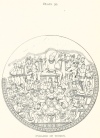
Click to enlarge
PLATE 30.
PYRAMID OF WOMEN.
[paragraph continues] Buddha, all hinge on this; and we saw that hell was also the theatre of the "Religious King Devil" in Tibet. Deva Rajah, too, in Ceylon was in hell, and the mighty darkness with which Buddha frightened his Nagâs, and the miraculous flames that issued from the "carpet of skin" on which he sat, can certainly claim cousinship with the tapers that are miraculously lighted in Christ's sepulchre in Jerusalem, when the Patriarch of the Holy City goes into it at Easter, and then brings them out as a prize for his zealous but combatant congregation, who wrestle for them wildly. *
The death of the year-god by all ancient nations was fixed at the Spring equinox. He died always on March 25th. This gives a much graver aspect to the change of date introduced in the Fourth Gospel (John xix. 14). From the three first gospels we learn that Jesus was upon the cross from 6 p.m. to 9 p.m. on Saturday. He ate the Passover with His disciples the day before, and he appeared to James on the night of the Crucifixion. This we learn from St. Jerome, who gives us a passage from the "Gospel according to the Hebrews."
"The Lord, after giving his shroud to the servant of the High Priest, went forth and appeared unto James. Now James, since he had drunk in the cup of the Saviour, had made oath not to eat bread until he had seen him risen from the dead. The Lord then said, 'Bring me a table and some bread.' And when he had received that which he commanded he took the bread and blessed it and brake it, and gave it to James saying, 'My brother, eat this bread, because the Son of Man has risen from the dead.'"
From this two facts emerge:—
(1) It confirms our contention that Jesus was a water-drinking Nazarite, for James, who according
to Eusebius was a Nazarite, bound by solemn oath to abstain from wine for life, could not have drunk out of the Lord's cup unless it was water only.
(2) That he was crucified on the day after the Passover and not on the day of the Passover, as John would make us believe.
Jesus is arrested by a vast "multitude armed with swords and staves." They include the "chief priests, the captains of the Temple, and Elders." They accuse him of calling himself the King of the Jews, and hand him over to Pilate, who learning that this offence took place in Galilee transfers Him to Herod Antipas. And now in the splendid palace of the Tetrarch a strange scene occurs. Jesus is dressed up in royal robes, and a white bandage blinds His eyes. Then all the soldiers of the palace, headed by the sober Tetrarch himself (Luke xxiii. 2) indulge in a sort of game of the "Blind Man's Buff" pattern. Individuals slyly pinch and hit Him, and cry, "Prophesy unto us who is it that smote thee"; and the farcical dressing up is carried into the solemn hall of judgment of Pilate, the representative of the most powerful monarch in the world. This officer, instead of severely punishing the soldiers for their mistimed buffoonery, joins in the mirth; and sets up a burlesque description on the Cross, although quite convinced of the innocence of the accused. And the chief priests are found even there, mocking him and "wagging their heads" (Matt. xxvii. 55). Ever since the arrest in Gethsemane they seem to have been amongst the mob. The same must be said, I think, of the "great company of women" that knew him in Galilee (Luke xxiii. 49). They seem ever present; indeed, He halts on His last fatal journey to preach to them, and even from the cross addresses an exhortation to His mother, though the buffooneries of the chief priests who were "wagging their heads"
there would have prevented her from hearing most of it.
Now do we get here sober history or a drama like the "Sacrificial Body of the Dead Year." Is this Tertullian's "Mystery" of the Resurrection? We see many characters dressed up—kings, chief priests, centurions, soldiers, thieves, multitudes,—actors remaining on the stage when they should be off it, and speaking set speeches in most unlikely places. And also as in the "Sacrificial Body of the Dead Year" we see a crowd of women, for according to Philo dancing and concerted song were prominent features in the nocturnal feasts of the Therapeuts.
In the midst of all this hurly-burly one prominent fact emerges. The "Christ" in the hall of Herod Antipas is not the historical Jesus. If it were really true that Pilate had found that he had no jurisdiction, and that he had handed over the prisoner to be judged by Antipas—the judgment pronounced by that ruler would, of course, have been final, and Jesus would have been at once released. But Strauss has shown that this "Herod" is a phantom due to the genius of the not very honest "Luke." Neither the first two gospels, nor the traditions that they drew from, knew anything of, this "Herod," and the Fourth Gospel also ignores him.
And the puzzle, if probed at all, shows many new difficulties. Herod Antipas, the "King of the Jews," is a creation of mere fiction, and yet he is the keynote of the mystery. The dress that he wears, the dress that he hands over to the sacramental "King of the Jews," is apparently the same dress as the dress of the Roman Catholic bishop when performing mass. A little official catechism, sold broadcast for two pence, at the Roman Catholic libraries, tells us that the "alb," or white tunic that descends to the feet of the priest, "represents the white garment that Herod
put on our Lord." It tells us also that the "Chasuble" represents the purple garment with which Jesus was clothed in derision as a mock king, the "amice" is the white rag that blinded His eyes, the "girdle, maniple, stole" are the cords that bound Him. The Eastern Church call the circle of hair left on the monk's head after the tonsure the "Crown of Thorns." Give to the bishop in addition to all this his pastoral staff which is imperative when he performs mass, and we have—Herod Antipas.
Now, premising that we have proved that the "Herod" of the Crucifixion story is a creation of fiction, several questions crowd upon us. Why is Herod Antipas dragged in at all? Why, too, is he dressed like a Catholic Bishop? Is "Herod" God Almighty handing over His dress (divine powers) to a mortal representative? If so, why is he placed in the camp of Baal-zebub? Why is the "amice" (the most ignoble part of the story) so highly prized? Has it any connection with the hood-winking rag of the Freemasons, who indulge in Bacchantic horseplay whilst the postulant is blinded?
All is a puzzle. To settle what was in the fourth Gospel at the date of Valentinus and what has been added since seems hopeless. If the proposition were presented for arbitration to—say an intelligent native of Japan—he might hold doubts whether the Jews were dealing with an evildoer who had earned the death penalty, or a man so blameless as to be able to claim the "glorification" of personating the Year-god at Easter.
"Take ye him and crucify him, for I find no fault in him" (John xix. 6).
This astounding non-sequiter of Pilate is capped by Caiaphas, who in the first three Gospels wants to kill everybody who dares to read the sacred books except in the most literal manner. In the Fourth
[paragraph continues] Gospel, however, this cruel old bigot seems to have quite adopted the explaining away of the Alexandrian Jews, and even their sacrifice of the Year-god.
"It is expedient for us that one man should die for the people" (John xi. 50). And the reason he gives is still more strange. He wants to make Israel into one camp. What camp? Plainly the camp of those who believed in the Year-god Abrasax.
It is a curious fact to start with, that "Herod" and his dress, if it were that of a Catholic Bishop, must have figured on the stage of a Buddhist Mystery play quite two hundred years before A.D. 30, for the French naturalist, Victor Jacquemont, who saw a Lâma performing a "Buddhist mass" in Tibet, declares that his dress was exactly that of a Roman Catholic Bishop in the same ceremony. And in the Tibetan play we saw bishops, priests, acolytes all properly dressed, and a Pope under a silken Baldachino.
Then the bell in a Buddhist country is a summons to gods to a feast, and in Tibet the "Religious King Devil" sounds his directly he begins to stab the "Sacrificial Body of the Dead Year." The Roman Catholic priest also sounds his bell directly he begins to immolate the wafer, as a summons to a feast. The body is already dead in Tibet, and there comes from it red wine which is lifted high in the air in a "cup." To John's Gospel has been added the account of a spear thrust delivered to the dead Christ, from whom comes blood and water, an incident that cannot be historical if the body were dead. But death by exhaustion, which is the result of a crucifixion, is inappropriate if we want a "cup" full of the fresh blood of the victim, for ceremonial purposes. This might be the reason why the spear-thrust was added by John. As in Tibet the Catholic priest lifts the cup into the air. It is sacramental "blood" and water, for a drop of the last has been added to signify Christ's
mortal as well as His divine nature. Other points may or may not have significance.
Herod and his host pursuing the little infant suggest the "corpse devils" in Tibet, stabbing at the baby New-year with their spears.
Then the arrest is all unreal in John's Gospel. "Father, the hour is come, glorify thy son," says Jesus, and He gives Himself up and seems to desire the proceedings to be hurried along. Before Pilate He refuses to plead, and in the Gospel of Nicodemus He declares that Moses and the Prophets have foretold His passion and resurrection, and He speaks like a fatalist.
One point more seems to have suggested a difficulty. Jesus in the three first gospels rises up a full-grown man, but Abrasax, as his name implies, is an infant when the New Year begins. That may explain the invention of Simon of Cyrene. Valentinus declared that he perished instead of Christ.
There is one point more. The Jesus of the first three Gospels had, according to His disciples, a concise formulary.
"Repent and be baptised for the remission of sins" (Acts ii. 38).
The Christ of Valentinus had one equally short.
"Verily, verily, I say unto you, Except ye eat the flesh of the Son of Man and drink his blood, ye have no life in you" (John vi. 53).
Now the interpretation of this in the Roman Church is that all who fail to drink the blood of Christ sacramentally every Easter will be punished everlastingly in hell fire. No two schemes of perfection could be more antagonistic. One sought to train the conscience of the individual by making him dwell over his own short-comings. The other would have him ponder not on his own sins, but on an arbitrary condemnation that he might incur for neglecting a shameful savage rite. For one hundred years, at least, the first was the only
[paragraph continues] "remission of sin" of the rising church. This is proved by the recently discovered Didache which gives the words of the early eucharistic rite as used about the year 130 A. D. The cup is called the "holy vine of David thy Servant." There is nothing about the body and blood of Christ. The allusion is to Psalm lxxx. 8, where Palestine is called a fruitful vineyard.
In Tibet the New Year, as we have seen, was a baby, and Buddha, under a baldachino of satin like the pope in the old days of Rome, comes in attended by priests and acolytes with orthodox chasubles, and albs, and he protects the little infant with a coating of flour, or, as I suggest, S’iva's white ash. Now one fact stands out in the troubled water of early Christian controversy, and that is that some sects in Alexandria, whether followers of Christ or Serapis is here unimportant, introduced a baby covered with flour in their occult rites.
There is nothing about a descent into hell in the story of Jesus as read in the first three Gospels, or even in the earliest version of the Apostle's Creed. Again we can separate the Gnostic Christ from Jesus. But without doubt Origen, Clement of Alexandria, Augustine, Cyril and others believed in this descent, and even debated such horrible questions as whether Jesus felt the torments of the flames, and whether like Buddha he cleared out hell or only took away the orthodox.
In the old days in France on Rogation Sunday a great dragon went before the Cross in the procession with a long tail filled with chaff. This chaff represented the souls in hell. And the third day, for the festival lasted three days, the tail was empty, "by which it was understood," says Hone, "that the first two days the devil reigned in the world, but that on the third day he was dispossessed of his kingdom." *
This short interval in ancient days was depicted on the stage with the most abominable and licentious orgies even in Christian churches. Smooth apologists deny this, but we know historically that up to the Reformation such scenes did occur in Christian edifices. Hone in his "Mysteries" describes these "Bacchanalian and Calendary rites," monks disguised as mummers, mummers disguised as monks, the Paternoster read backwards, a donkey brought up to the Communion Table and a mock litany pronounced with imitation of a donkey's braying, "demoniacal dances," "ballads borrowed from the streets and brothels."
The Therapeuts, according to Philo, represented Miriam and Moses on the stage with elaborate part-singing and solemn dances, and the Buddhists had their Inebriating Festival.
Philo, an initiate of the Religion of Serapis, living in Alexandria, describes these "impure mysteries."
"Indecency approaches and insults the most holy temples." He tells us of "devotees performing unhallowed sacrifices," "offering victims that ought not to be offered." He talks of an "impure piety, a debauched service." *
The worship of Serapis reached Rome 146 A.D.; "but the Senate soon found," says Jacobi ("Dictionnaire Mythologique") "its rites so licentious that they were forced to forbid them."
Tertullian assails the "Eleusinian dissipations" of the followers of Valentinus, who imitated the oaths of secrecy, the long initiations, the reticences and pious falsehoods of their model.
"All the divinity lies in their secret recesses. There are revealed all the aspirations of the fully initiated, the entire mystery of the sealed tongue, the symbol of virility." †
287:* Picart, "Ceremonies, etc.," III. p. 143.
293:* Hone, "Ancient Mysteries described," p. 134.
294:* Philo. "Cain and his birth," sect. 28.
294:† Tertullian. "Adversus Valent." cap, I.